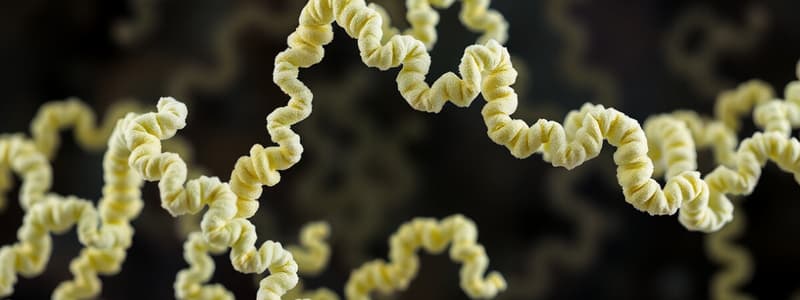Podcast
Questions and Answers
What indicates tissue damage in the context of enzymes in blood samples?
What indicates tissue damage in the context of enzymes in blood samples?
- Low enzyme concentration
- Presence of enzymes in blood (correct)
- Presence of enzymes only in cells
- Absence of any enzymes
How do competitive inhibitors function in enzyme activity?
How do competitive inhibitors function in enzyme activity?
- They enhance the active site's function
- They bind to an allosteric site
- They change the enzyme's structure permanently
- They block substrate binding at the active site (correct)
Which enzyme is specifically associated with liver health?
Which enzyme is specifically associated with liver health?
- ALT (alanine aminotransferase) (correct)
- ADH (alcohol dehydrogenase)
- PL (pancreatic lipase)
- Lipid enzymes
What role do lipids play in the structure of cell membranes?
What role do lipids play in the structure of cell membranes?
Which of the following is true about ectothermic animals' lipid membranes?
Which of the following is true about ectothermic animals' lipid membranes?
How do amino acid side chains influence protein folding?
How do amino acid side chains influence protein folding?
What role do enzymes play in cellular reactions?
What role do enzymes play in cellular reactions?
What defines the active site of an enzyme?
What defines the active site of an enzyme?
Which of the following accurately describes a characteristic of competitive enzyme inhibitors?
Which of the following accurately describes a characteristic of competitive enzyme inhibitors?
What structural feature allows proteins to exhibit unique chemical surfaces?
What structural feature allows proteins to exhibit unique chemical surfaces?
Which of the following statements is true regarding chemical reactions in cells?
Which of the following statements is true regarding chemical reactions in cells?
How does the sequence of amino acids in a protein affect its function?
How does the sequence of amino acids in a protein affect its function?
What is the main function of a lipid bilayer in a cell membrane?
What is the main function of a lipid bilayer in a cell membrane?
Flashcards
Amino Acid
Amino Acid
Building blocks of proteins, differing by side chains (R groups).
Protein Folding
Protein Folding
Process where peptide chains fold into specific 3D shapes essential for function.
Hydrophobic Amino Acids
Hydrophobic Amino Acids
Amino acids that prefer to be inside the protein, away from water.
Hydrophilic Amino Acids
Hydrophilic Amino Acids
Signup and view all the flashcards
Enzyme
Enzyme
Signup and view all the flashcards
Active Site
Active Site
Signup and view all the flashcards
Transition State
Transition State
Signup and view all the flashcards
Competitive Enzyme Inhibitors
Competitive Enzyme Inhibitors
Signup and view all the flashcards
Penicillin
Penicillin
Signup and view all the flashcards
ALT enzyme
ALT enzyme
Signup and view all the flashcards
Competitive inhibitor
Competitive inhibitor
Signup and view all the flashcards
Fluid mosaic model
Fluid mosaic model
Signup and view all the flashcards
Ectothermic animals
Ectothermic animals
Signup and view all the flashcards
Study Notes
Protein Structure and Function
- Proteins are polymers of amino acids linked by peptide bonds
- Twenty natural amino acids differ by their R-group (side chain)
- Amino acid side chains create a unique chemical surface on a protein, influencing its function
- Hydrophobic amino acids tend to cluster inside a protein; hydrophilic ones are typically on the exterior
- Chemical interactions between side chains stabilize a protein's 3D shape
Enzyme Function
- Enzymes are proteins that catalyze reactions by lowering activation energy (energy needed to start a reaction)
- Enzymes work by binding to a substrate at the active site
- Active site's shape is crucial for specific substrate binding
- Enzymes stabilize the transition state, an intermediate step in a reaction, making the reaction proceed more easily
- Competitive inhibitors resemble the substrate and block binding at the active site
- Non-competitive inhibitors bind to a different site, altering the enzyme's shape and inhibiting its function
Enzyme as Diagnostic Markers
- Enzymes are often confined within cells and not usually present in blood
- Tissue damage or cell breakage releases enzymes into the bloodstream
- Measuring enzyme levels in blood can help diagnose tissue damage/disease
- Examples like ALT (liver enzyme) and PL (pancreatic enzyme)
Enzyme Inhibitors as Drugs
- Some drugs are enzyme inhibitors - they block a specific enzyme's activity
- Competitive inhibitors bind to the active site, preventing substrate binding
- Non-competitive inhibitors bind elsewhere altering the enzyme's shape, blocking the active site's function
- Examples: Penicillin inhibits bacterial enzymes
Cell Membranes
- Cell membranes are primarily composed of a lipid bilayer
- The lipid bilayer features hydrophobic tails (fatty acid chains) and hydrophilic heads
- The hydrophobic tails face inwards, while the hydrophilic heads face outwards interacting with the watery environment.
- The "fluid mosaic model" describes the fluidity of the lipid bilayer, which allows proteins to move within the membrane
- Membrane lipid composition can change in response to environmental temperature changes.
General Cell Properties
- Cells are the basic units of life
- Each cell is enclosed by a lipid membrane
- Cells contain genetic material, generate and utilize energy, and can reproduce
Studying That Suits You
Use AI to generate personalized quizzes and flashcards to suit your learning preferences.




